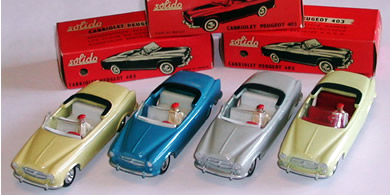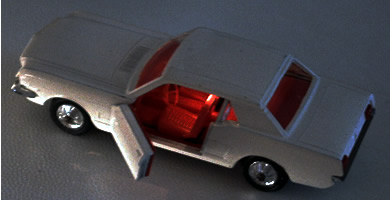Updated on 2011, October 27 In recent years, as never before, collecting obsolete models, such as 1:43 scale ones, has reached a high level of fierce passion. Let's face it: during the sixties, the models were children's toys that were purchased willingly by their parents because, deep down, they liked them too. Some parents, bought them for themselves and they started collections that became more and more extensive and interesting. The search for the missing pieces has always been a big problem. Sometimes they travelled hundreds of miles just because they had heard that someone in this place, was selling one or more of the models they were looking for. To solve this problem the collector's small markets were created, literally taken by storm by collectors. Today the markets are falling: with eBay and a huge market has entered our living room via the Internet. Once past the initial distrust there was only an embarrassing wealth of options and the regret of not being able to buy everything you see. By doing a search with the single keyword "corgi", in the toys and models section, in all countries of the world, you find about 10,000 different lots whose auction expires within a week: about 1400-1500 lots a day! It is also too difficult and tiring to make your own choice. But then we are sure that whatever model we are looking for, it will eventually appear in front of us within a few days. If, however, you focuses your attention on a particular collection, you can perform a search of only the few items of interest and this is much more fun and relaxing. Today the famous "100" series of the French Solido is undoubtedly one of the most interesting collections, due to the high value of its material, the sustainability of its value over time, the limited space it takes and the boundless fascination it exerts on the collectors around the world. Composed of only a hundred of models, one better than the other! They were all made from the late fifties to early seventies, right the period that I find more fascinating, as it is clear by reading the other pages of this site. Actually, some numbers have not been produced yet,
but some others were assigned to different models with the numbers marked
with "bis": for example the number 113 is the Fiat Abarth
and the 113bis is the Ford Thunderbird convertible. Of course, if you
are truly passionate about these models you start looking for different
colours and the collection immediately exceeds more than 1000 pieces,
but the research can be done much easily by just searching for the variations
of the models that we like. Below, some different colours of the Aston
Martin DB5 (# 130). The "100" series is a very diverse series. All the Solido models were numbered more or less progressively: road cars, race cars, vintage cars, buses etc. Only later (during the seventies and eighties) Solido began to number the series, differentiating them by type. So the beautiful Bugatti Royale 41, 1930, model No 136 of 1964, in the eighties became n. 4136, losing quality, among other things. This re-numbering can sometimes create problems
for collectors: still referring to the Royale # 136, it is normal for
someone to buy one for € 30-40 in perfect conditions and with its
original grey box marked "2" (with interior strictly red as
in the picture below). But if, after opening the package that the postman
has just delivered, we discover that we bought for that price a "4136"
we feel cheated: the 4136 is worth much less (€ 5-10) and it is
not part of our collection, even if a novice observer would not see
the difference. There are models for everyone in the series "100".
The fans of racing cars and sports cars will find many different Formula
One, produced in various colours, usually with the pilot in the driving
seat and with the race numbers and others with decal decoration. Often,
the decals were provided on a small sheet included in the package, for
the buyer to place them, if they deemed it necessary: As an example,
see photos of the n.187, Alfa Romeo 33 / 3. This obviously creates some
confusion in recognizing the real decals from those that were added
by the owner and one can may mistakenly exchange an added variation
for an original one. But even in the early models there are different
variations, all with factory-applied decals: the race numbers can be
large or small (eg on No. 107 - Aston Martin 3.5 L), some bands may
be present or not. Below, see some variants of the decal Giulia TZ (art.
148). For the fans of the classic car collection, "L'Age
d'or" offers some interesting reproductions that are part of the
"100" series. There are a total of 9 models, all beautiful
(see photos). Two of these, the Mercedes Benz SS form the 1928, represent
the same model, one with the folding top up (No. 132) and the other
with the folding top open and the windshield folded down (No. 137). In my opinion, however, the ultimate charm of the
sixties is reflected in the models of the "Grand Tourisme GT series.
I report here a detail of Solido catalogue that represents them all
together. Another group of super popular models that are
very sought after is the convertible type (very often with driver and
always with suspension and riveted base). Their value usually exceeds
100 euro if the model is complete with box: the Mercedes 190 SL (No.
105), the Alfa Romeo Giulietta spider (No. 106), the Peugeot 403 cabriolet
(No. 108, see photo below, with four different colours), the Renault
Floride (No. 109), the Simca Oceane convertible (No. 110) and the Ford
Thunderbird convertible (No 113bis). They are fantastically beautiful
models that are a must in a collection of quality. It seems fair to
point out , in this regard, that the Giulietta spider has a female driver
and not a man. It was also produced without the driver, but if you find
a male driver at the steering wheel you can be sure that it was added
by the owner. It is not uncommon to find the drivers of Verem Version,
produced on Solido molds, on Solido models, in order not to leave the
model incomplete: keep an eye, then, on the pilots, if their colour
is too sharp and lucid, they might be of recent manufacture. Pay also
attention to the "re-edition" models which often differ only
in more "modern" painting and in the writing on the box. In the second half of the sixties we find the models of the " haute fidelité” series: the Maserati 3.5 L Frua (known as the" Mistral ") No 139 and the Panhard 24 BT n. 143. The first is fairly common and it costs about € 50-60; the other, less common, is worth € 70-100. With these models, the Solido brand comes close to the new standards imposed by the other brands, but the initial fascination begins to fade. A production characterised by original details slowly surrenders to the laws of the market. The models are beautiful, that's for sure, but also Mebetoys made a Mistral comparable to this and Dinky Toys has made the 24BT. The same can be said about other newer models.
For example, the Mangusta De Tomaso (No. 166) was also made by Dinky
Toys (without open doors but, perhaps more beautiful) and Corgi Toys
(without openings but with the funny and original mechanism of release
of the of the frame-engine-suspensions block mechanism used on the Lotus
Elan S2). And, again, the Citroen SM with a Maserati engine, No 184,
which is not as beautiful as the one produced by Corgi Toys, which in
addition has the open trunk which can be opened by lifting the rear
parcel shelf. Many
other things could be said about this wonderful "100" series,
but these pages are mainly discursive and not meant to dissect every
possible technical aspect of the subject. I feel, however, to recommend
the lovers of models to visit "Les Jouets Solido" website
series dedicated to Solido models of the "100" and "10"
series. On it you will find information on various Solido catalogues,
on the combination of models with boxes, on the variants etc.The address
is http://www.jouets-solido.net.
It is worthwhile to visit him. Thank you, dear friends, to have read these pages
and for having followed my work so far. I hope I have done something
useful and interesting for you. |
|

























































 The case of No 129 - Ferrari 2L5 it’s remarkable, it was produced
both with shaped wheels and with spoked wheels (see photos of both versions).
Moreover, notice that also the formula one cars are fitted with very
well done suspensions: in some cases the rear arms are movable, adding
realism to the rear suspension functioning (eg No. 167 - Ferrari V12
Formula One). All models have a riveted base just to prevent themselves
to be de-assembled or handled.
The case of No 129 - Ferrari 2L5 it’s remarkable, it was produced
both with shaped wheels and with spoked wheels (see photos of both versions).
Moreover, notice that also the formula one cars are fitted with very
well done suspensions: in some cases the rear arms are movable, adding
realism to the rear suspension functioning (eg No. 167 - Ferrari V12
Formula One). All models have a riveted base just to prevent themselves
to be de-assembled or handled.



















































